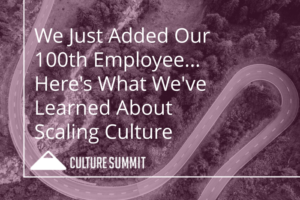
What We’ve Learned About Scaling Culture to 1000 Employees
Welcome to part three of the scaling company culture series! Don’t miss part one, “What Your Company Culture Needs at 10, 100 and 1,000 Employees,” or part two, “We Just Added Our 100th Employee… Here’s What We’ve Learned About Scaling Culture.”
Whether your company is already growing at breakneck speed or you’re sure you’re on the verge of something big, one of the first things you need to start reading up on is scaling company culture.
After all, there’s a reason your company is doing well: it’s got a certain something that’s making your team and your customers flourish, and you want to make sure you don’t break whatever’s working when you multiply tenfold.
So, why not ask people who have already done it?
This is by no means a comprehensive how-to for scaling culture to 1000 and more, but we think these are three lessons worth learning from HR leaders and executives who have been there, done that:
Lesson #1: Former BlackRock Exec Says Put Your Ear to the Ground
Charting a course for company culture past 1000 employees often starts with a map of where the leadership team wants to go. There’s nothing inherently wrong with getting your values straight (in fact, that’s #1 on our list of how to scale culture), but the planning process shouldn’t be exclusively high-level leadership oriented; it should also take into account what attracted your employees to the organization in the first place.
“I start by talking to all levels of employees about what makes the company unique from their perspective and their ideas about possible improvements for the future. Then I take time to compare and reconcile the differences and opportunities amongst levels and departments,” says David Dalka, keynote speaker and Managing Director of Fearless Revival, who led numerous critical project teams that redefined industry business models at BlackRock during its 80 to 800 employee growth phase. “That feedback analyzed empirically, allows everyone to figure out which items you should attempt to scale.”
“One of the cultural values that surfaced during the early days of BlackRock was our team’s ability to incrementally innovate to create a dramatically different process from what everyone else was doing,” continues Dalka. “We were challenged to destroy the jobs we had to build new ones that contained higher and higher value work that created better outcomes for all stakeholders. You can only do that in a company that empowers its employees and sees an abundance of opportunity, not scarcity.”
Lesson #2: Lyft Says Nurture Cross-Departmental Partnerships In the Recruiting Process
Ready to be impressed? Since 2014, the San Francisco-based transportation company Lyft has scaled from 80 to 2,000 employees. The company hired 1,230 new employees in 2016 and is set to exceed that number in 2017…. all while maintaining an excellent 4.0 overall employer rating on Glassdoor.
There isn’t necessarily one secret to maintaining culture, retention, and candidate quality and satisfaction while growing so quickly. But among many great ideas like moving from “culture fit” to “values fit” to speed up the hiring process and building authentic community connections, we want to highlight the team’s focus on nurturing cross-departmental partnerships throughout the recruitment process.

Image captured from “Nailing Culture During Hypergrowth: The Lyft Story,” presented by Lever and Teammable. Click here to view the entire webinar.
“When some companies think about underrepresentation, they often set broad, company-wide diversity goals,” says Tariq Meyers, Head of Inclusion & Diversity at Lyft. “But what ends up happening if you don’t take a departmental approach is that you’re not really able to figure out what perspectives are missing by level, team, and organization. So, when I’m working with department heads, I often invite the talent acquisition leadership, recruiters, sourcers, and coordinators to join me with my team, department heads and business partners along with hiring managers in the interview loop to get in a room and ask, ‘What perspectives are missing in your room?’”
Lesson #3: Former Exxon Mobil Exec Says Don’t Forget the Follow Through
When Millie Bradley, retired Exxon Mobil exec, was scaling 200 different company cultures with 100,000 employees, the key was the follow through. Bradley was surprised to find that the culture and implementation of culture needed to be renewed over time. So right at the top of her list with clear global policies, management buy-in, and extensive training comes stewardship and monitoring.
When Millie Bradley, retired ExxonMobil exec, was scaling the company culture across 200 countries and 100,000 employees, she realized that long-term success takes follow through. Bradley realized that the implementation of culture needed to be continuously reinforced to be sustainable. So right at the top of her list of advice — along with clear global policies, management participation, and extensive training — comes stewardship and monitoring.
“Operating management is ultimately responsible for a culture of integrity and ethics, so ownership of all violations of policy, annual stewardship to senior management of organizational culture, and face-to-face participation in the training of employees is critical to sustainability,” writes Bradley. “Making stewardship of ethics a management stewardship item, along with operating excellence and financial performance, sends a clear message to the organization about the importance of culture and values.”
Are you in the process of scaling company culture past 1000? Let us know in the comments what you would add to this list!
BlackRock, diversity and inclusion, Exxon Mobil, lyft, Recruiting, Recruiting Best Practices, scaling culture, Scaling culture to 1000